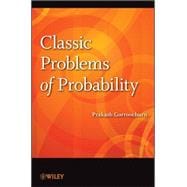Classic Problems of Probability

Classic Problems of Probability
- ISBN 13:
9781118063255
- ISBN 10:
1118063252
- Edition: 1st
- Format: Paperback
- Copyright: 05/02/2016
- Publisher: Wiley
New From $78.10
Sorry, this item is currently unavailable.
List Price $78.88 Save $0.78
New
$78.10
Print on Demand: 2-4 Weeks. This item cannot be cancelled or returned.
We Buy This Book Back!
Included with your book
Free Shipping On Every Order
Note: Supplemental materials are not guaranteed with Rental or Used book purchases.
Extend or Purchase Your Rental at Any Time
Need to keep your rental past your due date? At any time before your due date you can extend or purchase your rental through your account.
Summary
Detailing the history of probability, this book examines the classic problems of probability that have shaped the field and emphasizes problems that are counter-intuitive by nature. Classic Problems of Probability is rich in the hostory of probability while keeping the explanations and discussions as accessible as possible. Each of 35 presented problems end with a listing of the latest relevant publications on the topic, and the author provides detailed and rigorous mathematical proofs as needed. For example, in the discussion of the Buffon needle problem, readers will find much more than the conventional discussion found in other books on the topic. The author discusses alternative proofs by Barbier that lead to much more profound and general results. The choice of random variables for which a uniform distribution is possible is also presented, which then naturally leads to a discussion on invariance. Likewise, the discussion of Bertrand's chord paradox involves much more than stating there are three well-known possible solutions to the problems; rather, the athor discusses the implications of the indeterminacy of the problem as well as the contributions made by Poincare and Jaynes. This approach was used for all of the problems in the book.






